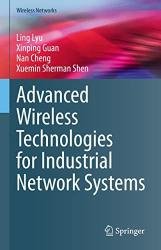 Название: Advanced Wireless Technologies for Industrial Network Systems
Название: Advanced Wireless Technologies for Industrial Network SystemsАвтор: Ling Lyu, Xinping Guan, Nan Cheng, Xuemin Sherman Shen
Издательство: Springer
Серия: Wireless Networks
Год: 2023
Страниц: 210
Язык: английский
Формат: pdf (true), epub (true)
Размер: 36.6 MB
This book provides a comprehensive overview of wireless technologies for industrial network systems. The authors first describe the concept of industrial network systems and their application to industrial automation. They then go on to cover the role of sensing and control in industrial network systems, and the challenge of sensing and control in the industrial wireless environment. Then, the existing techniques for resource efficiency information transmission are introduced and studied. Afterward, the authors introduce sensing and control-oriented transmission for industrial network systems, which take advantage of spatial diversity gain to overcome the interference and fading, which in turn improves the transmission reliability without expending extra spectrum resources and enlarging the transmission delay. Subsequently, edge assisted efficient transmission schemes are introduced, which integrate the capacities of communication, computing, and control to relieve the contradiction of resource limitation and massive data. Finally, the authors discuss open research issues and future works about information transmission in industrial network systems.
Industrial network system is referred to as a new generation of control systems in industrial automation, where the sensing and control information are frequently exchanged over wireless communication networks to achieve industrial monitoring. The wireless communication technology provides a bridge between sensors, controllers, and actuators to enable the flexible and low-cost communication services for sensing and control applications in industrial automation. Despite the appealing advantages of wireless communication, the harsh industrial environment and scarce spectrum resource make it very challenging to meet the high-reliability requirement of information transmission for control. Compared with the traditional wired communication, wireless communication in the industrial plant environment suffers from intensive electromagnetic, co-channel interference, and complex channel fading. These adverse factors may make the wireless network fail to deliver the necessary system information update to the controller within the desired deadline, leading to severe deterioration of control performance. In addition, the separation of control and actuation involves the data transmission of control commands over shared wireless channels. In general, the more information the controller sends, the more precise actuation becomes. However, the limited energy and spectrum resources make the functionalities on sensing, transmitting, and control quite restricted.
Multiple input multiple output (MIMO) is a key technology to improve the performance of transceivers in wireless communication systems. The transmitter and receiver with multiple antennas make it possible to send concurrent signals; thereby, MIMO has the ability to increase the capacity and spectral efficiency for wireless communication systems. With the advancement of wireless industrial networks and the increase of industrial Internet of Things (IoT) devices, the application of massive MIMO technology to industrial networks has attracted active research. However, in the industrial IoT, the massive number of sensors and IoT devices makes the number of user entities (UEs) much larger than the number of base station antennas. Therefore, the application of massive MIMO in industrial IoT creates a completely different situation from conventional massive MIMO.
Contents:
Скачать Advanced Wireless Technologies for Industrial Network Systems
